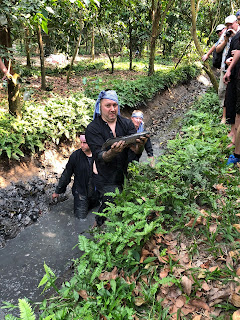We started Day 5 with a boat ride up the Mekong river to visit local craftsman and the river’s famous floating market of Cai Rang. The river is busy everyday and we witnessed that as we met or passed tour boats; boats delivering or preparing to sell their goods at the floating market; barges both large and small hauling everything from sand to rock to container cargo; fishing boats and others just moving on the river. Several of the boat operators live in houses along the river. Some houses had mangrove poles stacked against them or on the river banks.
These poles are used for foundations of houses. The poles can last 50 years.
Some of the river vendors live on the river but others have outside jobs and market their products from the boat on a part time basis.
Tidal flows impact the river and in the morning the tide is coming back in. Jessica, our tour guide, explained that high tide would occur around 4:00 pm. One noticeable threat to the river is the large amount of garbage both on the shore and in the water. Jessica explained that the garbage constitutes an overall challenge to the health of the river and ultimately poses a threat to the ocean environment.
On our first stop we visited a rice noodle market. We were able to watch and participate in the making of rice noodles:
The rice is ladled onto a hot cooking surface.
The rice is steamed for a few seconds.
Jennifer lifts the rice mixture with a wicker roller.
Jennifer rolls out the rice to dry.
Laying dried rice paper on the shredder.
Rice is cut into noodles.
Once the noodles are made the marketplace packages rice noodles for sale plus makes a pizza that is unique to this market. The pizza is not at all like American pizza with its main ingredients of rice noodles and tomato paste, but was still very tasty!
Continuing up the river we visited the Cho Noi or floating market.
The Cai Rang people from the countryside load their boats and come down the river to the market. They will live on the boat for 3 to 4 days while they sell their produce. Once they sell the produce, they go back home to refill their boats. For the market, people go from boat to boat to purchase the different products. Once we stopped at the first boat, other boats would come up selling other items, which demonstrated their entrepreneurial side. The class bought fresh and tasty pineapple, papaya, and mango. Pineapples were sold for for $1, mangoes for $2.
Don, Bob and Jay shopping on a floating market boat.
Pineapple for sale
Mango samples
During our bus ride after leaving the floating market, Jessica told us more about fruit and rice production in Vietnam. Vietnam exports 700 million tonnes of rice each year and the Mekong River area grow 70% of the total rice consumed in the country. As we drove and visited about the rice, we also passed corn fields, mango fields, jack fruit farms, cucumber, watermelon and banana trees. Rice is still the main crop and is planted two to three times a year, depending on the soil and area.
Lori getting the class a good deal on fertilizer.
Fertilizer and chemical price list.
We stopped and visited a seed and chemical dealer who caters to the area rice producers. Seed cost is around $25 USD for 40 kg (90 lbs). Fertilizer was $20-$25 USD per 40 kg bag. Fertilizer blends were similar to what we use in the US.
We also able to watch rice being harvested.
Rice harvest in bags that are dropped off on the fly.
Kubota rice harvester at work.
Custom rice combines were rolling in the fields. It took about 30 minutes to harvest a one hectare field. The custom combines receive roughly $300,000 to $350,000 Vietnamese dong for a hectare of rice. That equals a range of $13 to $15 per hectare or $5.50 to $6.00 per acre. After harvest, they turn the ducks out to graze on the fields. What a Vietnamese custom cutter and his crew thought of 30 Americans tromping through the field is anybody’s guess but that custom combiner made the day for a lot of these South Dakotans.
Jace in the field.
Jared, and Justin checking the straw.
Harvested rice ready to be picked up.
Out next stop was Vam Xang Orchard to enjoy a delicious local lunch. Several of the class learned how to make traditional Vietnamese pancakes, Banh Xeon.
Bob and Jessica cooking pancakes.
The group in traditional Vietnamese farm clothing.
Tanse is ready to fishing
Hand fishing is just like it sounds, wading down muddy channels using only hands to search for small catfish.
Heather and Lorrin in search of a catch.
Grant and Garret work together.
Chris catches the first fish of the day.
Jake with a fine catch.
The fisherman and fisherwomen were all gamers! On the way to the fishing channels we walked through their orchard and learned about the 40 types of fruit grown there. The enthusiasm for what they do is evident in hospitality, energy and pride in their product.
We concluded the day with a delicious meal at Sao Hom Restaurant in Can Tho. It was another successful day in the books for Class X in Vietnam. We learned that agriculture can come to the consumer in many forms and that the leadership to capture the opportunity can help drive its message.
Ryan Vander Berg and Lorrin Naasz reporters, Lee Freisen &. Jay Esser, photographers





























No comments:
Post a Comment